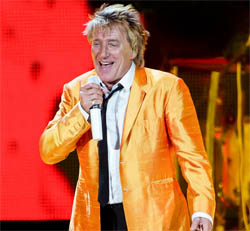
Early Adopter
The desire to travel lighter also informs, at least in part, his preference in consoles. “I used to have racks and racks of outboard gear, but I have close to nothing now because it’s all onboard,” he notes.
A long-time DiGiCo user, Brogaard first took a D5 Live console on tour in 2001 while beta testing the prototype for DiGiCo and, then, in 2007, was the first to use an SD7 on a tour.
The move to the SD7 was predicated by the console’s overall layout and higher sampling rate. “I think the SD7 provides improved low and high end in comparison with the D5.”
When it comes to monitors, more is not less, more is just right. On stage, two identical monitor rigs – each consisting of a pair of D5 Live 112EX consoles, two Lexicon PCM 91 effects units and four Yamaha 990 or 900 reverbs – are deployed.
One is devoted to Stewart and background vocals, mixed by Sven Jørgensen, while the other, manned by engineer Mark Willett, is used for the nine instrumentalists in the band. Put simply, it’s the best way to ensure everyone on stage has eyes and ears on their mix as often as possible.
Like his choice of stacks and consoles, Brogaard’s familiarity with products by AKG, Shure and Neumann influenced the tour’s microphone package. Drums were almost exclusively an AKG matter, outfitted with a D 112 for kick, two D 5s for snare top and bottom, a C 451 on hi-hat, and C 419s on toms. Three Neumann KM 184s handled overhead.
“We fiddle around with placement most days,” Brogaard says. “The kick is pretty consistent, but the snare mics never seem to end up in the same spot. We try to place them so they point across rather than straight down, so we get the rim shots and as much rattle as possible out of the bottom mic.” A similar mic set was applied for percussion, with AKG C 414s as overheads.
With the exception of the Leslie cabinet for keyboardist Charles Kentis’ Hammond B3, which were mic’ed with an a C 451 on the upper speaker and D 112 on the lower, all keyboards were mixed down to two channels and run direct into Radial direct boxes.
Working Well
Shure SM57s, as usual, were the exclusive choice on electric guitar cabinets. Both guitarists also have dedicated acoustic channels (one 6-string each and one 12-string), as does Stewart and string player J’anna Jacoby, who played acoustic in one song.

Radial DIs were also the choice for bass, acoustic guitars, Jacoby’s violin and mandolin, and the band’s 3-piece horn section. Horns were captured with AKG C 418 clip-ons, all running through AKG PT 4000 wireless.
All vocalists sang through AKG C 5900s, Stewart’s working with a PT 4000 wireless system. “I did a lot of work with AKG in the early days when they first started coming out with wireless systems, and they just work really well for Rod,” Brogaard explains. “The 5900 is a very smooth microphone. They’ve changed the capsule a little bit, so it’s a bit more open than it used to be, so we’re still trying to polish up the old ones and use them because they work really well for his voice.”
Following a round of promotional dates coming up in support of Stewart’s first Christmas album, Merry Christmas, Baby, as well as the publication of his autobiography by Random House, Brogaard intends to further tweak the system in anticipation of a 2013 tour.
“The next thing is networking,” he says. “Each box has its own DSP control, so we still end up running a lot of copper. I want to talk to Meyer about finding a way to do that in a smarter way with a digital signal path.”
Stewart’s popularity endures, exemplified by overall album sales in excess of 150 million and 18 Grammy nominations. But what Brogaard loves about his gig has nothing to do with sales stats or the hardware lining Stewart’s mantle. Instead, it’s rooted firmly in his respect for Stewart as a performer, artist and individual. “He’s an extremely musical person who gives an enormous amount on stage, and that’s what makes this job for me.”
And by constantly working to update the live concert rig, he’s doing all he can to ensure the audio performance gives just as much every night. “I think I’ve done close to 3,000 shows with the guy, so we’re hoping we’re going to get it right sooner than later,” he says, laughing.
Based in Toronto, Kevin Young is a freelance music and tech writer, professional musician and composer.
(Go to the next page to read more about the new Meyer LEO system.)


